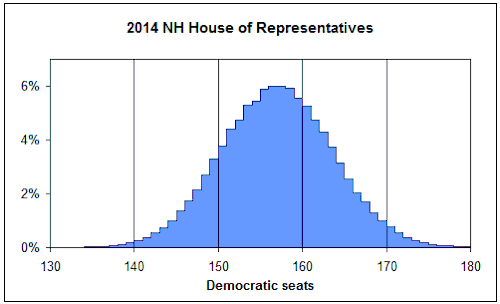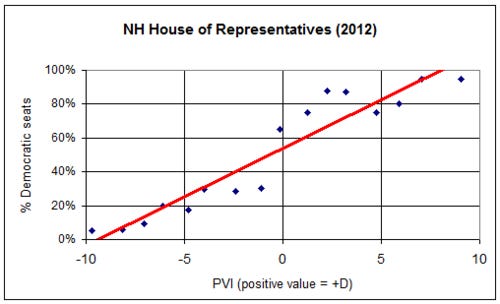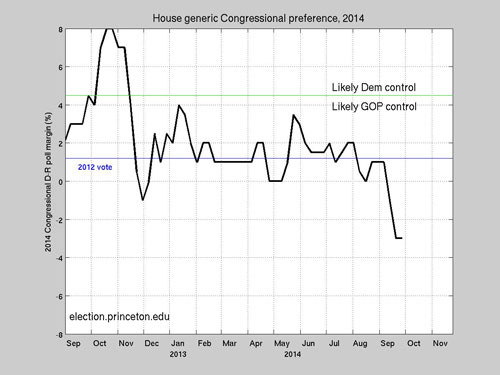Our 2014 forecast model for the New Hampshire House projects Republicans will regain control of the 400-seat chamber with a substantial majority. If the election were held today, the model predicts Republicans would win 244 seats to 156 for Democrats.
The model is based on just two variables, a partisan analysis for each of the state’s 204 House districts and national polls measuring the generic congressional ballot preference.
We create a baseline win probability for each district based on its Partisan Voting Index, which compares the district’s presidential vote over the last two elections with national results. A D+2 district, for example, voted more Democratic than the nation at large by two percentage points. Our model calculates that a generic Democrat running against a generic Republican in that district had about a 60% win probability in 2012.
Our model adjusts the baseline probability to reflect the current national mood as measured by generic congressional ballot polls. Those surveys, in which voters are asked, “Do you plan to vote for a Democratic or a Republican candidate in your congressional district?” are highly predictive of the actual popular vote.
We’ve found three analysts who aggregate results from generic ballot surveys. Their methodologies for calculating the average result differ. Today’s Huffington Post average gives Republicans a 44.0%-43.0% advantage; Talking Points Memo has the GOP up by a 43.7%-41.9% margin; and Real Clear Politics calculates a 46.5%-42.5% lead for Republicans. Our model averages the three for a 2.3% GOP advantage.
For much of the year, generic ballot results have been relatively even between the two parties. As the pollsters transition from surveys measuring all registered voters to “likely voters,” Republicans have now taken a clear lead. The chart below, from the Princeton Election Consortium, shows an ominous (for Democrats) trend over the last two months.
Our model does not attempt to judge the strengths or weaknesses of individual candidates or their campaigns and does not predict results for individual House races. Nor does it make adjustments for any differences in partisan enthusiasm between New Hampshire and the nation at large.
Analysts who do study the individual contests have published estimates ranging from a more modest 209-191 Republican advantage by SNHU’s Dean Spiliotes to a 250-150 prediction by state Rep. Steve Vaillancourt (R-Manchester).
Andy Smith, director of the UNH Survey Center, has developed a forecast model based on results from the Survey Center’s generic ballot poll for the New Hampshire House. His latest prediction of a 264-136 Republican advantage is based on a five point lead (37%-32%) for Republicans on the August New Hampshire House generic ballot question.
We’ll be watching for movement in the generic ballot surveys over the course of the election season that could indicate a change in the electorate’s mood. We’ll update our model each week to reflect those changes.





